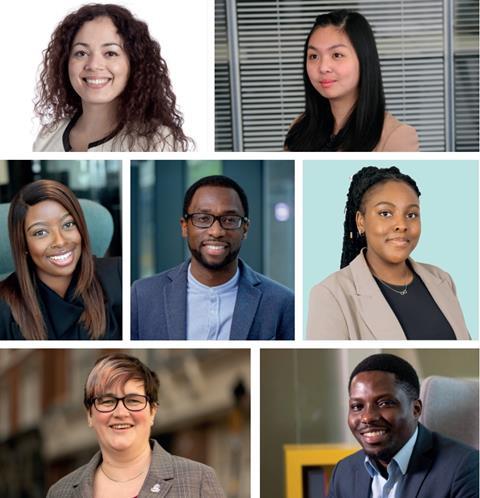How can construction recruit and retain talent to develop a more diverse and equitable workforce? Hollie Tye reports on a roundtable hosted by Faithful+Gould and Building
While the construction industry has long been talking about the importance of diversity, there seems to have been little progression. The same demographic continue to take up the most space, leaving an uninviting and often inaccessible workplace for many who sit outside those parameters.
Building magazine, in partnership with Faithful+Gould, gathered a panel of experts from across the industry to explore how construction can move beyond conversations and put action in place.
The panellists, chaired by Building special projects editor Jordan Marshall, discussed the importance of visibility, mentorship and an inclusive work culture as well as external factors that could become real drivers for change.

Tackling education
Why has the sector struggled with diversity in the past? Jessa Lee, quantity surveyor at Stace, felt it began in education: “The option of construction wasn’t even presented to us.”
She considered the professional career options presented to schoolchildren to be limited, with medicine, law and accountancy being more familiar as options. Lee said she only fell into construction by accident and felt that young people need to be shown a wider range of available possibilities.
“It’s not just an attraction and recruitment issue,” added Sharon Slinger, owner and director at Construction Rainbows. “It’s a retention issue as well. We’re doing lots of work in getting diverse people through the door and they’re treated like rubbish, so they’re leaving.”
You can’t be what you can’t see
Rumbi Chiparamandu, graduate quantity surveyor at Faithful+Gould, discussed the issue of visibility. “You can’t be what you can’t see,” she said, explaining that people can feel like “there’s no space for you”. When Chiparamandu entered the industry, she didn’t see many black women and it took time for her to find mentors within the space. “They’re there – they’re not hiding – you just don’t see them,” she added.
Theresa Mohammed, partner at Watson Farley & Williams, echoed the sentiment. “There is a real problem with visibility. In the construction sector we do not showcase our diverse talent.” People applying for roles in this sector can become “disengaged” by seeing so few people who look like them or who come from diverse backgrounds.
Mohammed went on to say: “The barrier is that we don’t really want it enough.” Diversity is quick to be labelled a human resources issue, or something an organisation is striving to achieve “at some point”. But is it something companies really want? And are we holding leaders accountable?
Slinger said she couldn’t agree more, adding, “People always say: How do we change things? But you need the leadership force behind it to put things in place. And at the moment, we don’t have that in our industry.”
Interested in equality, diversity and inclusion?
Why not read the write up of our recent chat with Faithful & Gould’s diversity and inclusion lead Dara Jafari
It is all part of our Social Value Programme

Numbers speak
Lanre Gbolade, co-founder at Gbolade Design Studio & Paradigm Network, said it was important to champion black and Asian representation within the built environment, given the number of statistics that demonstrate the current state of the industry’s workforce.
He said: “15% [of our workforce] are women and 6% are black/Asian minority ethnic; 6% are disabled, and the statistics for LGBTQI+ are largely unverifiable - which is telling in itself. People don’t feel comfortable being their natural selves in that environment.”
Melissa Armstrong, cost manager at HB Reavis, believes people with different backgrounds can be encouraged to join the industry but when they do they can often be “marginalised and excluded”. To just hit quotas and tick a box is not enough, she said, adding that once we have those people within the sector then we need to retain them by being “committed to celebrating diversity”.
“Unconscious bias training can help,” said Lee. “But it’s more about the cultural shift needed.” She added that while she feels comfortable in her own workspace, within the industry as a whole it’s a different story. Part of the challenge, said Lee, is that people are unwilling to fully accept there is a problem as “people don’t like hearing that they’ve done a bad job”.
In light of the sector’s current challenges, facing unprecedented inflationary pressure and a record skills shortage, the discussion turned to whether external pressures could be a driver for change.
Gbolade said: “We’re seeing the impact of things like Brexit and potentially even covid.” He added that with people changing careers, leaving the industry and creating large gaps in vacancies, it’s a problem which companies need to start addressing but “it shouldn’t be just about putting bums on seats” but rather should be a “targeted driver”.
Being in the room
When talking about the importance of selecting representatives to attend events, Mohammed said it is “absolutely crucial” for diversity to be considered when selecting delegates. “It changes the tone of the events; it changes how it looks; it changes the conversations, the ideas and the type of interactions that go on.”

On this point, Slinger, Chiparamandu and Amos Simbo, founder of Black Professionals in Construction and construction director of Winway Group, said they had all recently attended the Real Estate Investment & Infrastructure Forum (UKREiiF) conference and shared their work on making it a different type of event, with a particular focus on diversity and inclusion.
Chiparamandu was chosen to represent Faithful+Gould at the event, but upon joining the delegate call she said “it became apparent that it was not diverse at all”. This was called out and the situation rectified within a week.
“What we also had was a buddy system in place,” Chiparamandu said: senior members attending were buddied up with graduates. This not only mitigated the worries of first-time attendees but also helped them to build connections with senior members of the team, which can be hard to achieve day-to-day. As a result, Chiparamandu said she now knows “how to navigate the room better”, how to present herself better and to feel like she “belongs in those spaces”.
At UKREiiF, the diversity not only of the delegates but also of the panels and dinner attendees was carefully considered. Slinger mentioned “the great work that Faithful+Gould and Atkins did at bringing younger people through as well”. The change brought about a “different atmosphere” compared with other industry conferences, and the team received positive feedback on the event’s vibrancy.
Gbolade made the point that “being in the room is great but you still need to have people there that want you in the room”. Sharing his experience of attending events, he said there were times “people turn their backs on me”. Being invited into the space is only the beginning; being made to feel welcome and included must also be addressed.
Simbo agreed, saying: “There’s so much more we can be doing to make sure people feel comfortable at these events.”
Pub culture
Alcohol was another hot topic, with Lee saying the culture surrounding alcohol at industry events can be exclusionary for people who don’t drink.
Chiparamandu added that “all the important conversations happen outside of work” and “if you’re not there, you’re missing out – which is unfortunate”.
“It goes back to the point of people recruiting in their own image,” Mohammed highlighted. If that goes unchecked, people are likely to hire those with similar interests and so organisations become homogeneous and stale. “And the risk is that it is that small group of people who get promoted,” she added, saying that the way to change this is to create pathways for diverse individuals to rise to the top.
Mohammed also pointed out the need to consider the timing of events. “In our sector, if we continue to plan events in the evenings or late afternoon, this could directly exclude people with caring responsibilities or make it challenging for them to attend.” As she emphasised, we “don’t know what demands people have on their time”.
Mohammed added: “We just need to be a lot more thoughtful, and once you put your mind to it, it’s not that difficult.”
For Gbolade, it is about going the extra mile, looking at your team and thinking, “What is the makeup here?” to ensure everyone is included.
Thoughtful leaders
A cultural shift is needed, but how do we go about encouraging more thoughtfulness from leaders? Lee said that, speaking to senior leaders, sometimes they “don’t always understand the appeal”, so it can be helpful to promote the financial benefits. Gathering and presenting data on the benefits is crucial.
Gbolade added that greater numbers of female leaders are needed in order to bring in a different perspective, while more employee networks need to be set up “so they can be empowered to make change”.
He added: “You need a top-down and bottom-up approach to get the whole organisation moving in a different direction.”
The benefits of mentoring were also discussed among the panel, with Armstrong saying she believes “more senior staff can learn something” from diverse individuals lower down the ranks and indeed be made aware of the value of a more inclusive workforce.

When the client says no
One of the biggest drivers of change within the industry is clients asking for the supply chain to do more on diversity and inclusion. “You can see it with HS2,” argued Slinger. “They [the contractors on the project] are investing in diversity because it’s being asked for. We need clients to make it part of the contract, because that will drive change.”
Mohammed agreed. “There are examples of organisations being rejected straight off the bat because they’ve attended tender interviews with all-male attendees,” she said.
She added that lessons can be learnt from the legal sector, where firms are using contextual recruitment and asking for submissions on diversity and social value, rather than just legal technicalities. She said: “It’s taken as a given that we know how to do our job. It’s a question of: what else are we bringing?”
Gbolade echoed the sentiment, saying that “clients are placing more importance on social value” but also extending that to project teams. He said it is essential to be thinking about bringing together diverse teams who can deliver a project based on lived experience so that the buildings and spaces “can best serve a mix of people”.
Let’s talk tokens
“I personally wouldn’t want to be promoted as a token to be there for the pictures,” stated Lee. “It’s got to be merit-based at the same time.” She said it is essential that the people being put forward are qualified and will demonstrate “the potential of what a diverse workforce can do”.
Simbo raised an interesting point, suggesting that “in most cases, people are not given jobs based solely on merit”. It is important that people recognise the significance of giving people a chance and allowing them to build on their experience and grow into the role, he said.
Mohammed added that we need “to critically examine the requirements we stipulate for jobs in the construction industry”. When a lengthy list of academic requirements and long periods of experience are stipulated, she said, construction firms are “are positioning themselves to exclude huge groups of people”. We need to consider what is essential for the role and what can be overlooked and then adjust job descriptions accordingly, she said.
Slinger argued that “if we could look at transferable skills rather than experience in the industry, we could have encouraged more people in”, particularly over recent years.
Gbolade said: “There’s still a disconnect, with some people not seeing others as the same to them,” particularly in the construction industry, where older, white males so often dominate the space.
“There’s a need in some cases to kick-start things with a little bit of tokenism,” he added. Often people from diverse backgrounds are good enough – “better in some cases” – but are still not being given the opportunity. Sometimes a helping hand is needed to allow people to reach their potential, he said.

To sponsor or not to sponsor
“This is where sponsorship comes in,” said Mohammed. “It won’t happen if we leave it to chance.” She said the sector needs to be facilitating introductions and opportunities by being active sponsors and allies.
Chiparamandu said it is important that sponsoring does not just fall to those from under-represented groups, as it carries risk. “Being from an under-represented group and wanting to sponsor someone, there’s a lot of pressure for the person you choose to outperform expectations,” she said. There is also the issue of whether the person you’ve brought through the door is going to be nurtured. Chiparamandu argued that we need our senior leaders in the business to have a “framework for sponsorship and be clear on those expectations”.
Mohammed said that while sponsoring “shouldn’t fall on the shoulders of diverse groups” it is “absolutely essential that people from the global majority and diverse backgrounds do it together with allies”.
She went on to say that “if we don’t, no one will” and that it’s important we support those in similar situations and “ease their path”.
For his part Simbo said: “People feel so much pressure, and perhaps that’s what makes it so difficult.” Companies need to think about how they’re hiring, but the conversations about that “tend not to happen between those who are actually hiring. That’s where the disconnect is,” he added.
Ways of working were also on the agenda, with the whole panel agreeing that flexible and part-time working would cast the net to a wider workforce. They saw little to suggest it wouldn’t work within the construction industry and consider it is time to start thinking differently.
Increasing the share of paternity leave was another suggestion, alongside more guidance being available for employees returning after an extended period of absence.
A sympathetic ear
Marshall ended the session by bringing up the elephant in the room: with an extremely diverse panel, the discussion was in a sense preaching to the converted. So how can the message be spread more widely?
“It needs to be in mainstream events, where they can’t escape from it,” argued Slinger. “We need middle-aged white men to be talking about this,” because they hold the majority of leadership positions and they listen to one another. “There are some people in that category who are doing loads on this, so we need to be highlighting them as well.”
It is about continuing education and raising awareness, which “we do all the time”, said Mohammed.
But the way to convert the unconverted would be making it “central to performance criteria”, she added. If it’s a part of the metric in respect of performance and career progression that you demonstrate not just awareness but what you’re actually doing within the space, then individuals can be held accountable. She said: “Until you make it conditional, people may shirk the responsibility.”
Round the table
Chair: Jordan Marshall, special projects editor, Building
Melissa Armstrong, cost manager, HB Reavis
Rumbi Chiparamandu, graduate quantity surveyor, Faithful+Gould
Lanre Gbolade, co-founder, Gbolade Design Studio & Paradigm Network
Jessa Lee, quantity surveyor, Stace
Theresa Mohammed, partner, Watson Farley & Williams
Amos Simbo, founder, Black Professionals in Construction and construction director of Winway Group
Sharon Slinger, owner and director, Constructing Rainbows



























